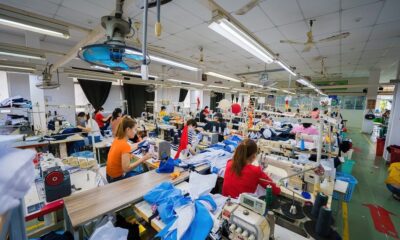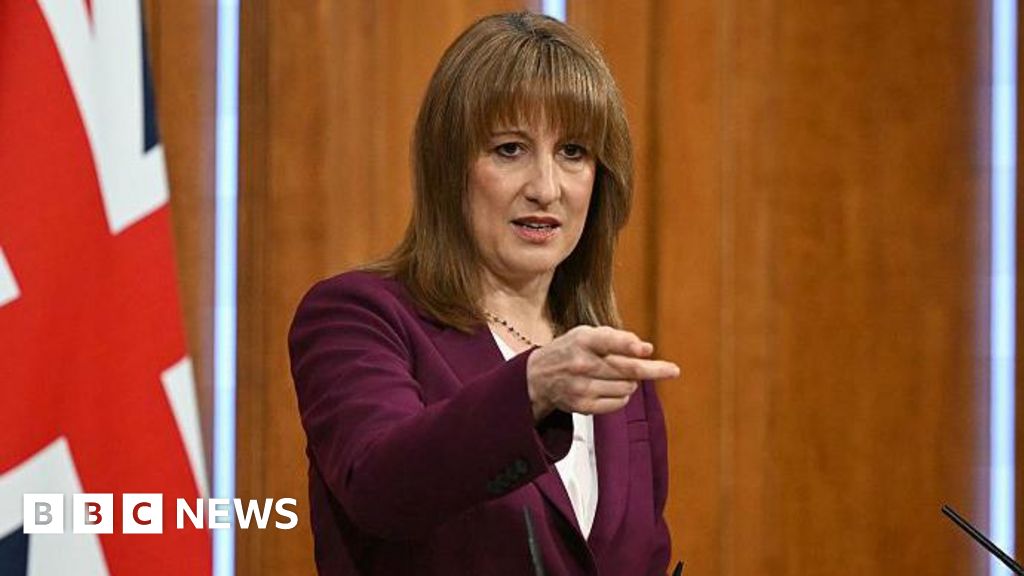Business
‘For national & economic security’: Trump admin mulls chip-based tariffs on foreign electronics, says report – what it means – The Times of India

The Donald Trump-led US administration is considering a plan to impose tariffs on imported electronic devices depending on the number of chips in each one of them, Reuters reported, citing three sourcesUnder the proposal, the US commerce department would calculate tariffs as a percentage of the product’s estimated chip value, in a move designed to push manufacturers to shift production to America.
“America cannot be reliant on foreign imports for the semiconductor products that are essential for our national and economic security,” White House spokesperson Kush Desai told Reuters, regarding the matter.“The Trump administration is implementing a nuanced, multi-faceted approach to reshoring critical manufacturing back to the United States with tariffs, tax cuts, deregulation, and energy abundance,” Desai added.Uncertainty remains about the scope of products that would be affected, tariff rates, and possible exemptions. The commerce department was weighing a 25% rate on chip content, and 15% for electronics from Japan and the EU, though figures were still preliminary, a source told the agency.
What will be the impact if tariff gets imposed?
If implemented, the policy would apply to a broad range of consumer goods, from toothbrushes to laptops, potentially raising costs for US households. Economists warned it could also worsen inflation. According to Michael Strain, an economist with the conservative American Enterprise Institute, the move would push up consumer prices “at a time when the US has an inflationary problem, with inflation clearly above the Fed’s target and accelerating.”He added that even domestically produced goods could get costlier due to higher tariffs on imported inputs.Trump has already rolled out sweeping tariffs this year, including 100% duties on branded drugs and 25% on heavy-duty trucks. Earlier in April, his administration launched probes into pharmaceuticals and semiconductors, calling foreign reliance a national security threat.A potential exemption linked to investments in US manufacturing, dollar-for-dollar credits only if a company shifts half its production to America, has been discussed but not finalised. Meanwhile, earlier proposals to exempt chipmaking tools faced pushback from the White House, with sources saying Trump dislikes carve-outs. Taiwan Semiconductor Manufacturing Co. (TSMC) and South Korea’s Samsung Electronics, the world’s biggest non-US chipmakers, could be among the hardest hit.
Business
Skims valued at $5 billion after new funding round as it accelerates store expansion

Skims underwear is displayed on a shelf at a Nordstrom store on March 25, 2025 in Corte Madera, California.
Justin Sullivan | Getty Images
Kim Kardashian’s Skims brand has raised $225 million in new funding led by Goldman Sachs Alternatives, valuing the shapewear and apparel company at $5 billion — up from roughly $4 billion after its 2023 round.
The deal comes as Skims nears $1 billion in annual net sales, six years after its 2019 launch, and marks one of the largest private raises for a U.S. consumer brand this year. BDT & MSD Partners’ affiliated funds also joined the round, Skims said Wednesday.
Skims plans to use the new capital to accelerate brick-and-mortar and international expansion, as well as product innovation and category diversification. The company has 18 stores across the U.S. in cities including New York, Los Angeles, Austin and Atlanta and one in Mexico, with plans to open additional stores overseas in 2026.
Skims said it’s laying the groundwork to become a “predominantly physical business” in the coming years, a pivot for a company that built its reputation as a digital-first direct-to-consumer brand.
“This milestone reflects continued confidence in our long-term vision and coupled with disciplined execution, positions Skims to unlock its next phase of growth,” CEO and co-founder Jens Grede said in a statement.
The new funding follows the debut of NikeSkims, a partnership with Nike that launched earlier this year and sold out within hours. The collaboration signals Skims’ ambitions to scale beyond its core shapewear products and into activewear, apparel and performance categories, pushing the brand further into the mainstream athleticwear market dominated by Lululemon, a handful of upstarts and Nike itself.
The new capital infusion could further delay an IPO from Skims. The company has been eyeing a public debut since at least 2024, based on statements by Grede.
The consumer IPO market has been largely stagnant in 2024 and 2025, with few fashion or beauty brands debuting as investors turn cautious on discretionary retail. By raising new private funding, Skims can continue to scale without immediate pressure to list.
“Skims stands as a solutions-driven apparel innovator, pioneering new categories and redefining everyday wear,” said Beat Cabiallavetta, global head of hybrid capital at Goldman Sachs Alternatives. “We look forward to partnering with management to pursue significant opportunities and deliver disruptive, sustained growth.”
Since its launch, Skims has built a cult following with its inclusive sizing, minimalist aesthetic and high-profile campaigns featuring global athletes and celebrities. Kardashian, who serves as chief creative officer, said the new funding marks “an exciting new chapter” for the company.
“We can’t wait to take Skims to the next level as we continue to innovate and set the standard for our industry,” Kardashian said.
Business
Shares of Swiss sneaker company On soar 20% as it raises guidance again

Logo of Swiss shoemaker On is displayed in a shop in Zurich, Switzerland, Aug. 28, 2025.
Denis Balibouse | Reuters
On raised its full-year guidance for the third quarter in a row on Wednesday after the Swiss sportswear company posted another three months of double-digit growth, bucking a slowdown in the sneaker market.
The company, known for its innovative approach to running shoes, is now expecting 2025 sales to reach 2.98 billion Swiss francs ($3.72 billion), up from its previous guidance of 2.91 billion francs, on a reported basis. On a constant currency basis, the company anticipates sales will grow 34% from the prior year, rising from its previous forecast of 31%.
The forecast is slightly above the 2.97 billion francs analysts were expecting, according to LSEG.
“Our focus on premium, on full-price sales, on innovation, on that intersection between performance and design is just resonating very strongly with the consumer, and it’s really setting ourselves apart,” CEO Martin Hoffmann told CNBC in an interview. “You see it in the results. We have strong top-line growth, we have a strong margin, so that shows that we stay fully committed to full-price sales, and this is across all our channels.”
Shares of On jumped more than 20% in morning trading Wednesday in New York.
During its 2025 third quarter, the sportswear company beat Wall Street’s expectations on the top and bottom lines.
Here’s how On performed compared with what Wall Street was anticipating, based on a survey of analysts by LSEG:
- Earnings per share: 47 cents in francs adjusted vs. 25 cents expected
- Revenue: 794 million francs vs. 763 million francs expected
The company’s reported net income for the three-month period that ended Sept. 30 was 118.9 million francs, or 36 cents per share, compared with 30.5 million francs, or 9 cents per share, a year earlier.
Excluding one-time items, On posted earnings of 43 cents per share.
Sales rose to 794.4 million francs, up about 25% from roughly 636 million francs a year earlier.
On’s rosy results come as competitors like Nike and Hoka plan for either a sales decline or slowdown in growth, as discretionary spending stagnates and tariffs take a bite out of shoppers’ wallets. In late September, Nike said it was expecting sales in its current quarter, which runs generally from early September to early December, to fall by a low single-digit percentage as it works to reignite innovation and streamline operations. Deckers, the parent company behind On’s fellow buzzy footwear brand Hoka, trimmed its sales guidance for Hoka in October.
Meanwhile, On is raising its sales guidance as it gears up for the holiday shopping season. Retail analysts expect most of the industry to lean heavily on discounts and promotions to drum up demand during the critical holiday shopping season, but On won’t even be offering a Black Friday discount, said co-founder and Executive co-Chairman Caspar Coppetti.
On will be “full price through the holiday season,” Coppetti said in an interview with CNBC. “This is against the backdrop of a very competitive and very discount-driven environment currently, and so this leveling up that we’ve done, and then just being able to command a much higher selling price, really sets On apart.”
While On is typically sold alongside brands like Nike, Hoka and Brooks Running, its holiday strategy is similar to those of luxury names. It’s part of the company’s strategy to be the most premium sportswear brand on the market by not just offering the highest prices but also the most innovative products across footwear and apparel.
Still far smaller than many of the legacy brands it competes with, On has slowly been chipping away at their market share primarily through innovation, where industry leader Nike has been criticized for falling behind.
Last year, On launched its Cloudboom Strike LS produced with its “LightSpray” technology, which makes performance running shoes using a spray gun in a matter of minutes. Runner Hellen Obiri was wearing the shoes when she broke the women’s record in the New York City Marathon by almost three minutes earlier this month.
“That’s a very strong validation,” said Coppetti. “Runners really do pay attention to what people are wearing now when they’re in a race, because these innovations trickle down and they inform their choices.”
Business
Heineken cuts strength of Foster’s lager as duty rises and sales slump

Heineken UK is cutting the strength of its Foster’s lager to take advantage of duty savings on weaker beers.
The brewer said dropping the lager’s strength from 3.7% to 3.4% would allow customers to “benefit from more competitive pricing as inflationary pressures continue to affect the wider market”.
It added: “This follows the introduction of differential duty rates by the UK government, which encourage brewers to innovate at lower ABV (alcohol by volume) rates in support of customers wanting to moderate their alcohol consumption.”
The change, which takes effect from February, would also support pubs and retailers with a “competitively priced classic lager”, it said.
Foster’s ABV was previously lowered from 4% to 3.7% in January 2023.
Heineken UK said: “The decision to adjust the ABV of Foster’s reflects our commitment to helping consumers make responsible choices, while supporting pubs and retailers with a competitively priced classic lager alongside a portfolio of brands across the price and ABV spectrum.
“Our master brewers have spent many months refining the recipe to ensure the taste remains unmistakably Foster’s – crisp, balanced, and refreshing.”
Off-trade sales of Foster’s fell by 13.7% to £252.8 million in the year to April, according to NIQ data.
A number of products have been reformulated since the introduction of new duty savings on beers with an ABV of 3.4% or below in August 2023, including Carlsberg Pilsner, Coors Light and Grolsch.
-

 Fashion1 week ago
Fashion1 week agoGermany’s Adidas achieves highest-ever quarterly sales in Q3 2025
-

 Business1 week ago
Business1 week agoFirst new Amazon electric heavy goods vehicles hit UK roads
-

 Sports1 week ago
Sports1 week agoShaheen Afridi Eyes First ODI Series Win as Pakistan Captain – SUCH TV
-

 Tech1 week ago
Tech1 week agoNokia, Rohde & Schwarz collaborate on AI-powered 6G receiver | Computer Weekly
-

 Tech1 week ago
Tech1 week agoThe Security Interviews: Colin Mahony, CEO, Recorded Future | Computer Weekly
-

 Tech1 week ago
Tech1 week agoOur Favorite Gaming Headset for Xbox Owners Is Discounted
-

 Fashion1 week ago
Fashion1 week agoVietnam’s manufacturing growth hits 15-month high as PMI climbs to 54
-

 Business1 week ago
Business1 week agoReeves lays ground for painful Budget, but will it be worth it?







